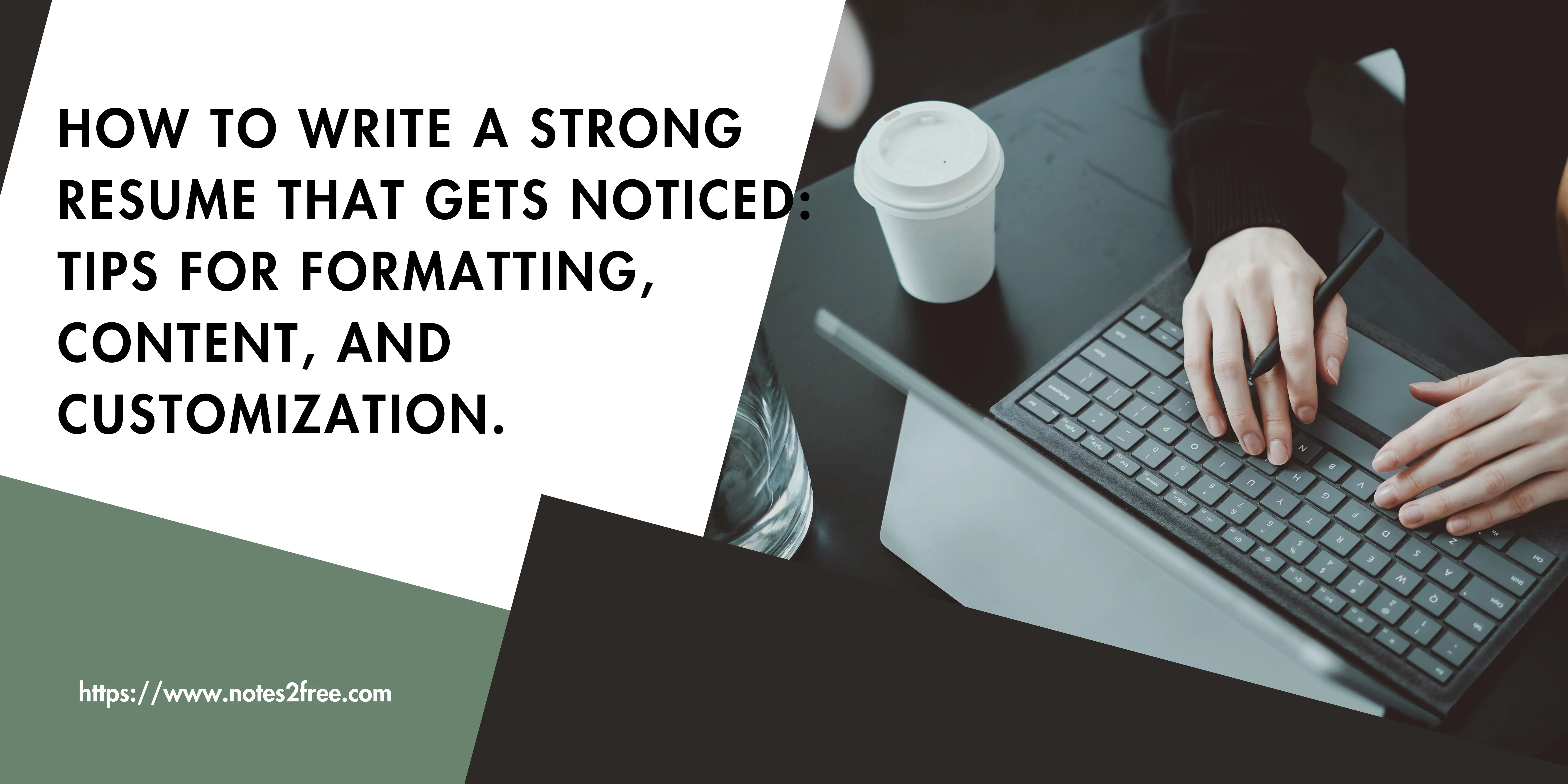
Tips guide tips for formatting, content, customization, how to write a strong resume, get noticed on recruiting time, and get your resume selected for your dream job.
Crafting a strong resume involves several key steps. Here's a detailed guide:
Add Contact Information:
Include your full name, phone number, email address, and LinkedIn profile (if applicable). Ensure that your email address is professional.
Create Resume Objective or Summary:
Write a concise, impactful objective or summary highlighting your career goals and key qualifications. Tailor this section to the specific job you're applying for.
Add Professional Experience to your resume:
List your work experience in reverse chronological order. Use action verbs to begin each bullet point, emphasizing accomplishments. Quantify your achievements with measurable results. Focus on the most relevant experiences for the position
Include Education Details on your resume:
Include your educational background, starting with the most recent degree. Mention your degree, major, school name, graduation date, and any honors.
Update Skills Section:
Highlight both hard and soft skills relevant to the job. Customize this section based on the specific requirements of the position.
Add Achievements and Awards to boost your resume:
Showcase any notable achievements, awards, or recognitions. Emphasize how these accomplishments relate to the job you're seeking.
Certifications:
Include relevant certifications that enhance your qualifications. Certifications can add credibility and demonstrate specialized skills. If applicable, include a section highlighting significant projects you've worked on. Describe your role, the project's impact, and any results achieved.
Keywords and Tailoring:
Use keywords from the job description to pass through applicant tracking systems. Tailor your resume for each application to match the specific requirements.
Formatting and Design with template:
Keep the design clean, professional, and easy to read. Use a legible font and maintain consistent formatting throughout. Limit the resume to 1-2 pages.
Add Proofread to the resume :
Eliminate typos and grammatical errors. Ask someone else to review your resume for a fresh perspective.
References:
Unless explicitly requested, it's common to exclude references on the resume. Simply state, "References available upon request.
Online Presence:
Ensure your LinkedIn profile aligns with your resume. Remove any unprofessional content from your social media profiles. Remember, the goal is to showcase your unique value proposition and make it easy for hiring managers to see how you align with their needs. Tailor your resume for each job application to maximize your chances of getting noticed.
Keywords and Tailoring:
Use industry-specific keywords from the job description to optimize for applicant tracking systems. Customize your resume for each application.
Formatting and Design Tips: Tips for Formatting Your Resume:
Clean Layout:
Choose a clean, professional layout that is easy to read. Use consistent fonts and maintain a balance between text and white space.
Font and Size:
Use a readable font (e.g., Arial, Calibri, or Times New Roman). Stick to a font size between 10 and 12 points for the main text.
Bullet Points:
Use bullet points for easy readability. Keep each bullet point concise and focused on accomplishments.
Sections and Headings:
Clearly define sections with bold headings (e.g., "Professional Experience," "Education," "Skills"). Maintain a logical and organized flow throughout.
Margins:
Set consistent margins (usually 1 inch) to frame your content. Avoid cramming too much information; allow some breathing space.
Consistent Formatting:
Maintain consistency in formatting for dates, bullet points, and indentation. Ensure a uniform style for each section.
Use of Bold and Italics:
Use bold for section headings and job titles to make them stand out. Italics can be used sparingly for emphasis.
Color and Graphics:
Keep it professional by using minimal color. Avoid excessive graphics; focus on content.
File Format:
Save your resume as a PDF to ensure consistent formatting across different devices.
Proofread:
Eliminate typos and grammatical errors. Pay attention to details, such as dates and contact information. By combining a strong content strategy with effective formatting, you'll increase the chances of your resume standing out and making a positive impression on potential employers.
So why is proper formatting so important?
One of the main purposes of academic writing, like all writing, is to communicate. Proper formatting can facilitate clear communication, signal to the reader that you are knowledgeable about how to communicate with others i n your field and convey a degree of professionalism. Proper citation helps your reader find supporting sources on the subject.
If a paper is disorganized, the reader’s attention is drawn to the sloppiness or inconsistency of the paper; if formatted neatly and properly, the reader’s attention can be focused on the content, with minimal distractions.
A Sign of Respect and Professionalism
Proper formatting and citation send a message to your school, your program, and other professionals that you respect the discipline and other researchers enough to give them credit and to follow the established general guidelines for research.
Especially for your dissertation committee and any submissions to professional journals, this is crucial – and can make or break your paper or article. Later on, in your profession, proper formatting is important to maintain professionalism.
It Develops Good Habits
Following formatting guidelines shows that you can follow directions, and gets you in the habit of working within the practice guidelines of your discipline. If you’re used to working in APA, MLA, CMoS, or whatever the accepted style is, it will become second nature when you’re working in the field, benefitting your overall work and helping to convey your knowledge of best practices.
Proper formatting is important, both when you’re in school and while you’re working professionally in your field. Find out what the required formatting style is, and if you can, acquire the latest edition of the style guide. You can often find them discounted on various websites, and many school libraries have multiple copies – just make sure you are using the most recent edition since there are always updates and changes with each revision.
Did you know that our editing team is comprised of editors who specialize in a variety of formatting styles, including Bluebook and MLA? This means that if your paper needs APA formatting, you’ll get an editor who knows APA, inside and out.
Content Tips:
- Contact Information: Include your full name, phone number, professional email, and LinkedIn profile. Make sure contact details are up-to-date.
- Resume Objective or Summary: Craft a concise, targeted objective or summary. Tailor it to the specific job you're applying for.
- Professional Experience: List work experience in reverse chronological order. Begin each point with strong action verbs. Focus on quantifiable achievements.
- Education: Include your educational background with the most recent degree first. Mention your degree, major, school, graduation date, and honors.
- Skills Section: Highlight both hard and soft skills relevant to the position. Use keywords from the job description.
- Achievements and Awards: Showcase significant achievements and any awards. Relate them to the job you're applying for.
- Certifications: Include relevant certifications that enhance your qualifications.
- Relevant Projects: Detail relevant projects, emphasizing your role and outcomes.
- Keywords and Tailoring: Use industry-specific keywords from the job description.
Online Presence:
Ensure your LinkedIn profile aligns with your resume. Remove unprofessional content from social media. By combining effective formatting with compelling content, you create a resume that is visually appealing, easy to read, and effectively communicates your qualifications to potential employers.
Customization:
Job Description Analysis:
Analyze the job description for key skills and requirements. Tailor your resume to match the specific needs of the position.
Objective/Summary Customization:
Customize your objective or summary to align with the job you're applying for. Highlight how your skills meet the company's needs.
Skill Emphasis:
Prioritize and emphasize skills relevant to the job. Align your skillset with the employer's expectations.
Professional Experience Alignment:
Tailor the professional experience section to highlight achievements relevant to the position. Quantify your impact with measurable results.
Keyword Integration:
Incorporate relevant keywords seamlessly throughout your resume. Optimize for applicant tracking systems (ATS) without sacrificing readability.
Cover Letter Customization:
Tailor your cover letter to complement your resume. Expand on specific experiences and skills mentioned in your resume.
Company Research:
Research the company culture and values. Customize your resume to reflect how you align with the company's ethos.
Networking Tailoring:
Adjust your resume when networking or attending job fairs. Highlight aspects of your experience that align with the event. By following these steps, you'll create a well-formatted, content-rich, and customized resume that effectively showcases your qualifications and increases your chances of standing out to potential employers.
